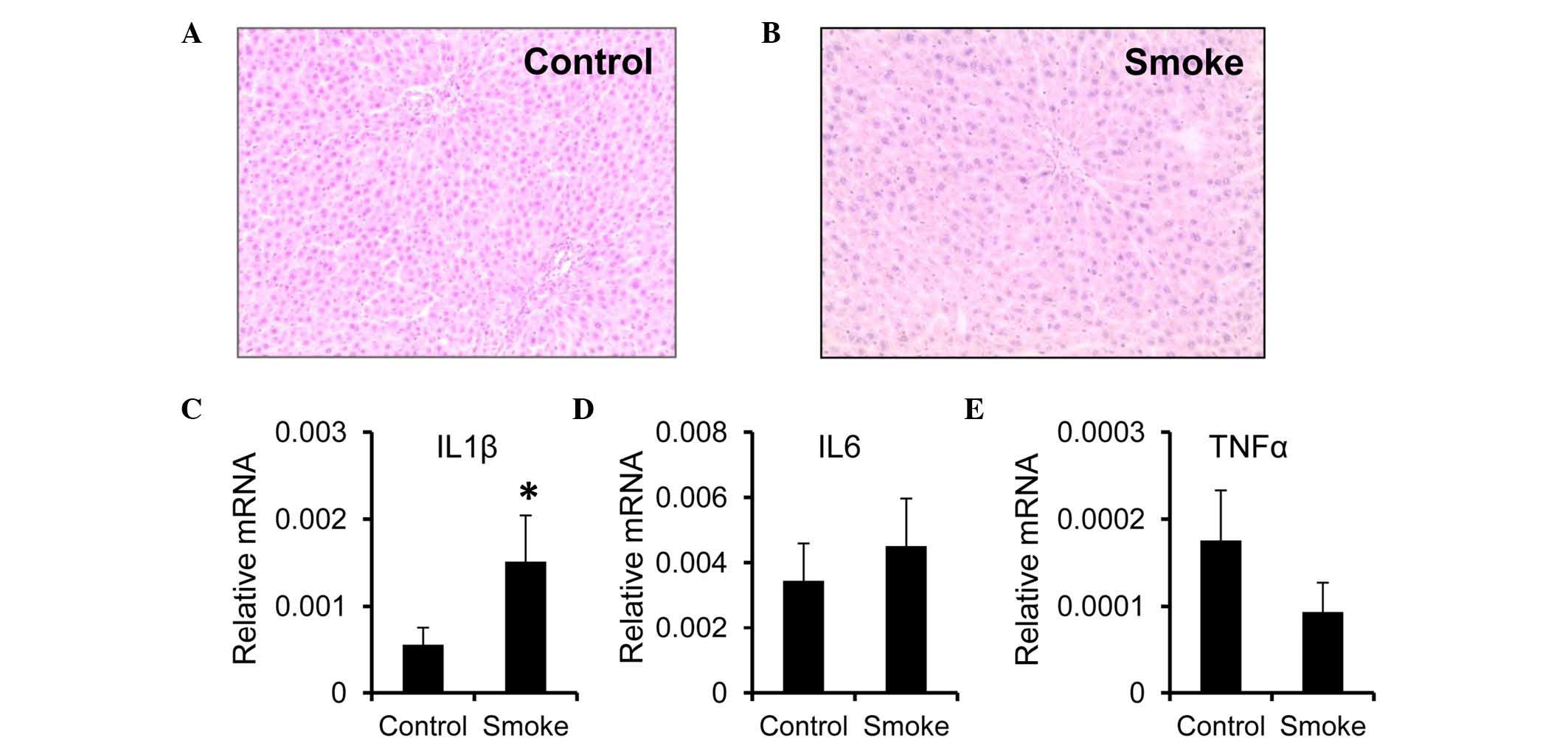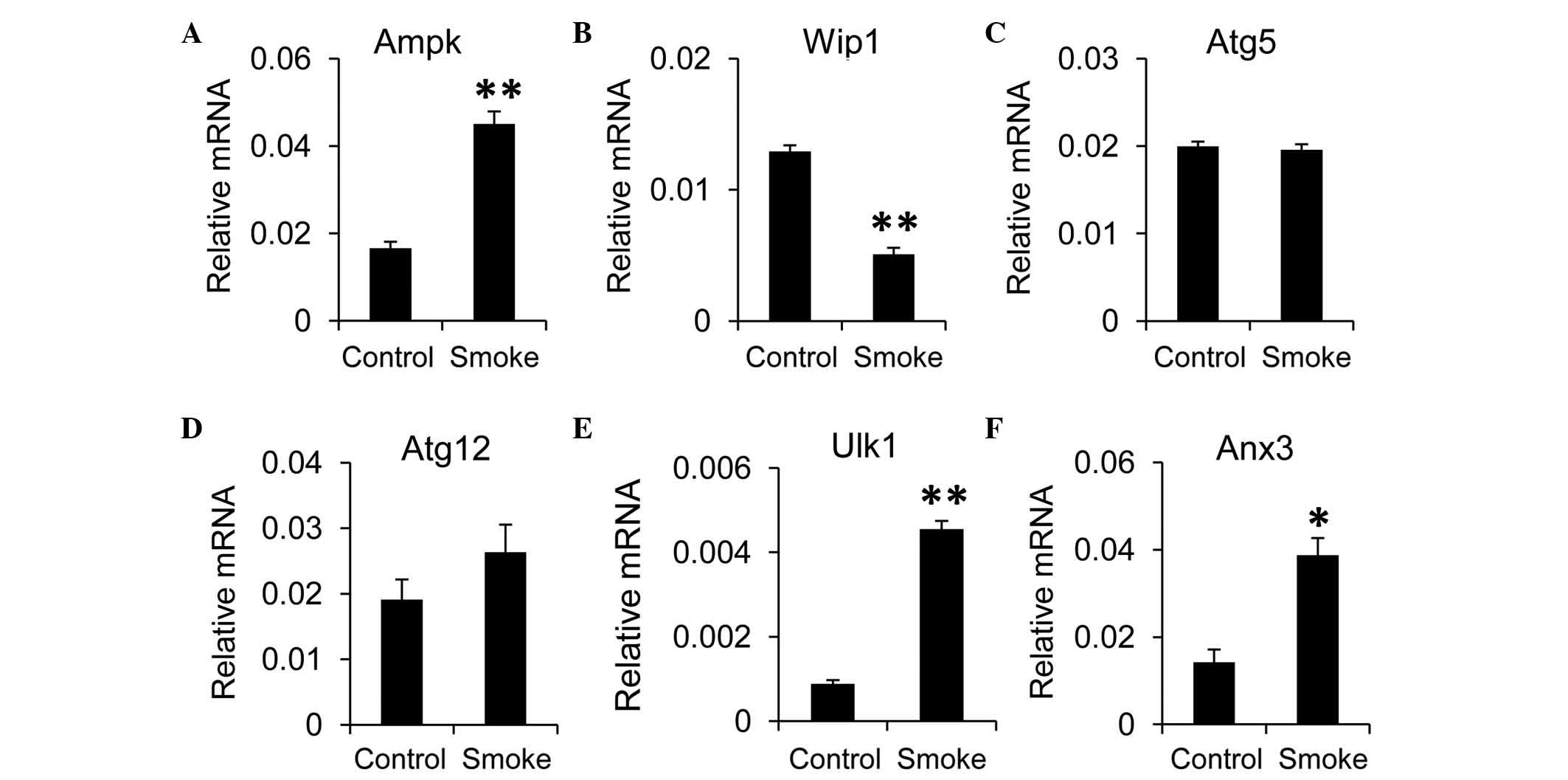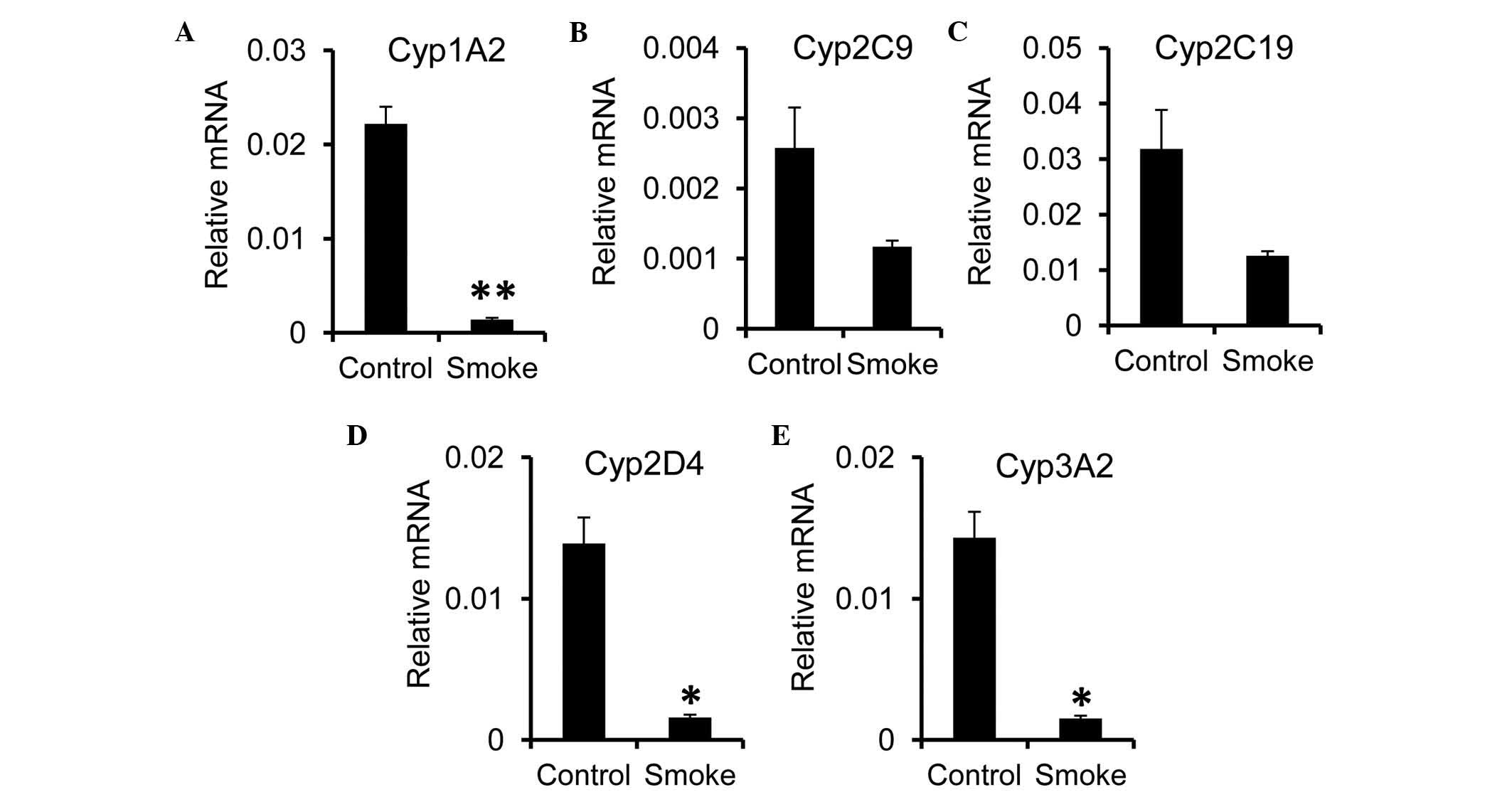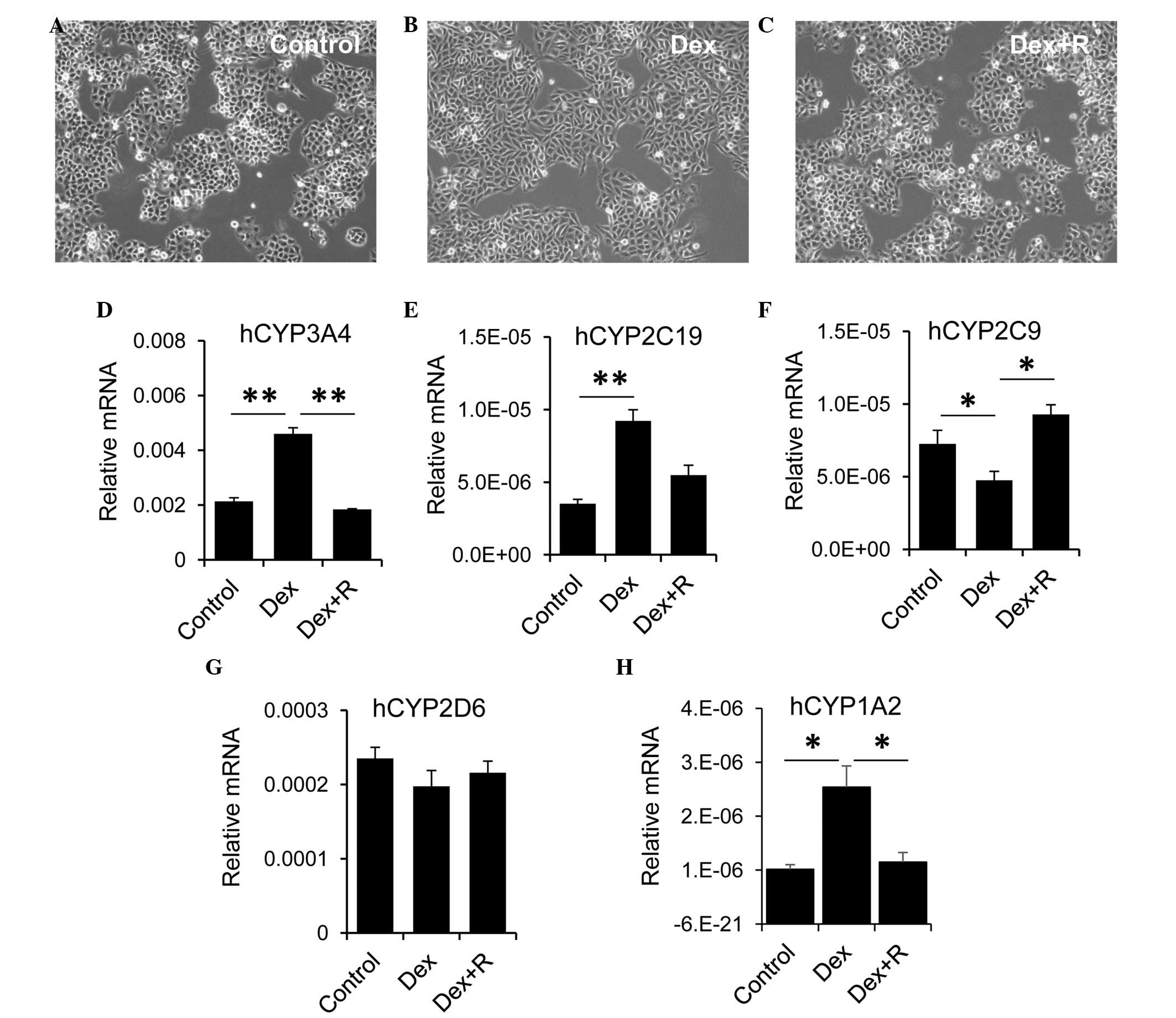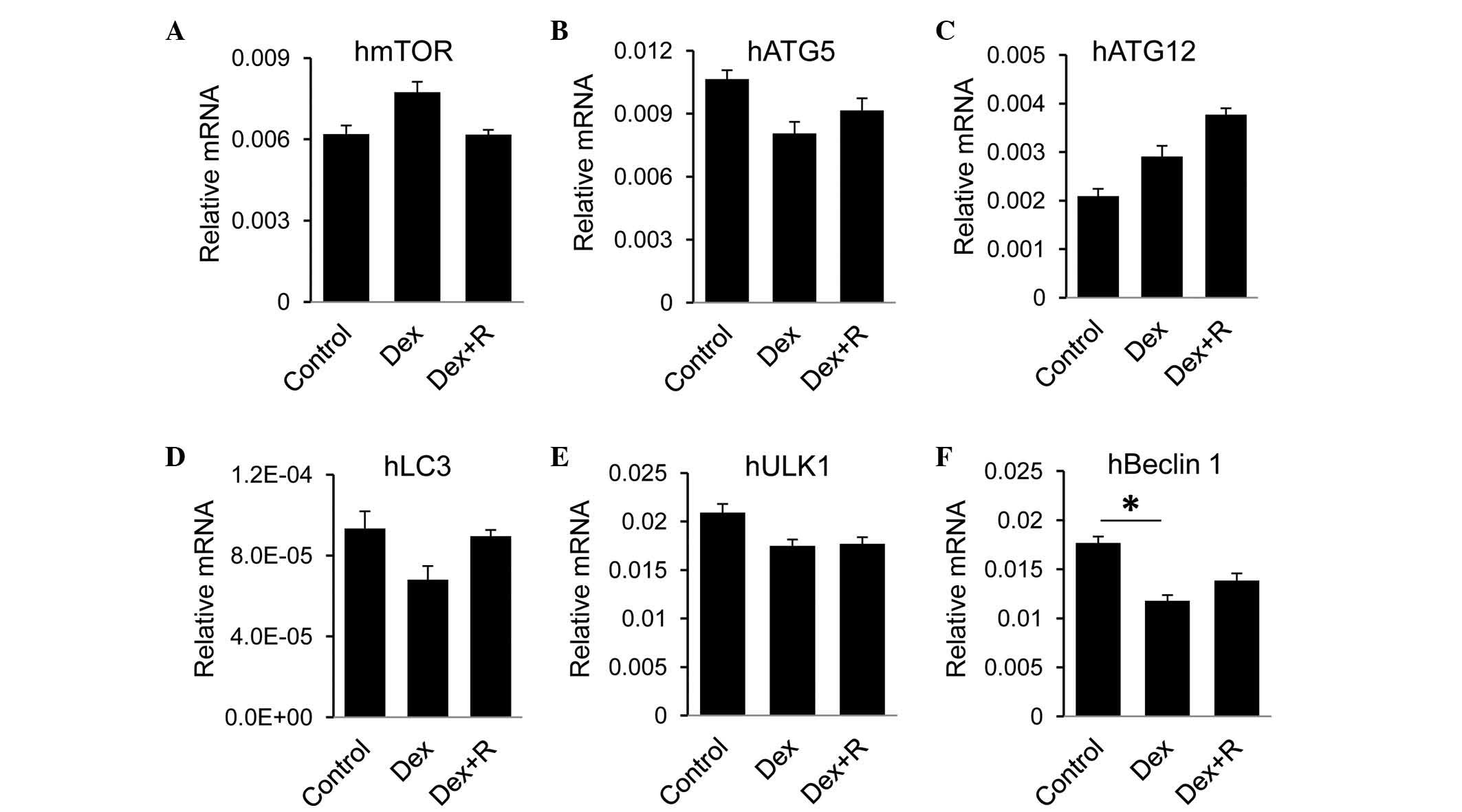Glucocorticoid receptor contributes to the altered expression of hepatic cytochrome P450 upon cigarette smoking
- Authors:
- Published online on: October 27, 2016 https://doi.org/10.3892/mmr.2016.5898
- Pages: 5271-5280
Abstract
Introduction
Cigarette smoke contains >4,000 toxic chemicals with hazardous adverse effects on almost all organs in the body (1). The major clinical consequences of cigarette smoking include chronic respiratory ailments, increased incidence of several types of cancer and increased risk of cardiovascular disorders (2,3). In addition, smoking may accelerate the progression of fibrosis in patients with chronic renal or pancreatic diseases (4,5). Although not considered a causative agent, smoking may have a negative effect on the incidence, severity and clinical course of liver diseases, including primary biliary cirrhosis, chronic hepatitis C infection, nonalcoholic fatty liver disease and hepatocellular carcinoma (6–9). The mechanisms underlying smoking-induced liver alterations are complicated and remain to be fully elucidated.
The liver is the critical site in the body for the removal of toxins, and process alcohol and drugs. To perform these functions, the liver expresses heme-containing enzymes of the cytochrome P450 (CYP) families (10). In humans, the CYP1, CYP2 and CYP3 families are involved in hepatic drug metabolism. Other CYP families are involved in the biosynthesis and metabolism of steroids and retinoic acid. The CYP1 family has three members, CYP1A1, CYP1A2 and CYP1A3. CYP1A2 is expressed predominantly in the liver and is responsible for the metabolism of several drugs, including theophylline, which is used clinically to prevent and treat the wheezing, shortness of breath and chest tightness caused by asthma, chronic bronchitis, emphysema and other lung diseases (11). In the CYP2 family, the CYP2C subfamily constitutes ~20% of the total hepatic CYP and is involved in the metabolism of a wide variety of drugs in clinical use (12). Although CYP2D6 represents only 2% of the hepatic CYP content in humans, it metabolizes >70 drugs (11). Among the CYP3 family members, CYP3A4 is primarily expressed in the liver and catalyzes the metabolism of a number of drugs, for example statins, which are used to treat hyperlipidemia (13). The expression of CYP is considered to be controlled by nuclear factor (NF)-κB through nuclear receptors (14). Pregnane X receptor (PXR) can recognize and bind to the responsive elements in CYP2B and CYP2C genes (15). Constitutive androstane receptor (CAR), a nuclear receptor, has been shown to be involved in the regulation of CYP2C9 and CYP3A4 (16,17). Glucocorticoid responsive element has been identified in the regulatory region of the CYP2C9 promoter (18). The activation of glucocorticoid receptor (GR) is essential for the induction of CYP3A4 by glucocorticoids (19).
The activation of NF-κB is affected by pro-inflammatory cytokines, including interleukin 6 (IL6), interleukin 1 (IL1), and tumour necrosis factor α (TNFα), which are promoted by chemicals in cigarette smoke (20). The development of inflammation is regulated by autophagy through a chain of elements, including autophagy-related protein 5 (ATG5) and ATG12 (21,22). The in vitro treatment of liver cells with ethanol has been shown to increase the expression of IL6, an effect which was markedly alleviated by rapamycin, an inducer of autophagy (23). However, whether autophagic activity is altered in the liver of cigarette smokers remains to be elucidated.
In the present study, a rat model of smoking was established to examine the effects of cigarette smoking on inflammation, autophagic activity, and the expression of nuclear receptor and CYP in the liver. It was found that smoking induced a reduction in the expression of drug-metabolizing CYPs in the liver through the regulation of nuclear receptors. These findings indicate the importance of considering metabolic ability in the liver of patients who smoke prior to prescribing drugs.
Materials and methods
Ethics statement
The present study was performed in strict accordance with the recommendations in the Guide for the Care and Use of Laboratory Animals of Tianjin Medical University (Tianjin, China). The protocol was approved by the Animal Care Committee of Tianjin Medical University (Permit no. 2010-0002). All surgery was performed under sodium pentobarbital anesthesia, and all efforts were made to minimize suffering of animals.
Reagents
TRIzol reagent was purchased from Invitrogen; Thermo Fisher Scientific, Inc. (Waltham, MA, USA). The TIANScript RT kit was purchased from Tiangen Biotech Co., Ltd. (Beijing, China). SYBR Green polymerase chain reaction (PCR) core reagents were purchased from Bio-Rad Laboratories, Inc. (Hercules, CA, USA). RPMI 1640 medium was purchased from Gibco; Thermo Fisher Scientific, Inc. Fetal calf serum was purchased from Hyclone; GE Healthcare Life Sciences (Logan, UT, USA). Dexamethasone (Dex) was purchased from Sigma-Aldrich; Merck Millipore (Billerica, MA, USA). RU486 (mifepristone), a specific antagonist of glucocorticoid receptor, was purchased from Sigma-Aldrich; Merck Millipore.
Animals and treatment
Male Wistar rats weighing 180±20 g and aged 6 weeks were purchased from the Model Animal Center of the Radiological Medicine Research Institute, Chinese Academy of Medical Science (Beijing, China). The rats were housed in standard laboratory cages (n=5) at 22°C with a 12 h light/dark cycle and free access to food and water. A total of 30 rats were divided into two groups (15 per group), comprising a cigarette smoking-exposed group and an unexposed control group. As described previously (24), the smoking group received whole-body exposure to the smoke of five unfiltered cigarettes (Daqianmen™; tar ≤15 mg, nicotine ≤1.1 mg and CO ≤13 mg) for 30 min, twice daily (prior to 9:00 a.m and after 5:00 p.m), for 14 weeks inside a 0.6 m3 custom plexiglass chamber (constructed in-house). The protocol for the control group was identical, but without smoke exposure.
Cell culture
LO2 cells (a gift from Chenghu Liu lab, NanKai University, Tianjin, China) were maintained in RPMI 1640 medium supplemented with 10% fetal calf serum, 2 mM l-glutamine, 100 U/ml penicillin and 100 µg/ml streptomycin at 37°C with 5% CO2. In the experiments, 10 nM Dex and 10 µM RU486 were added into the culture medium when the cells were 80% confluence.
Liver tissue sampling
At the end of smoking exposure period, the rats were anesthetized with sodium pentobarbital and sacrificed by cervical dislocation. The abdominal cavity was opened and the liver tissues were excised, rinsed in ice-cold PBS (pH 7.4), and then either stored at −80°C for the analysis of gene expression or fixed in 10% neutral-buffered formalin for the analysis of histology.
Hematoxylin and eosin (HE) staining
Following fixation in 10% neutral-buffered formalin, the liver tissues were embedded in paraffin and 5 µm thick sections were cut. The sections were then stained with HE solution (Solarbio Science & Technology Co., Ltd., Beijing, China) and images of the staining were captured under an Olympus IX71 microscope with a DP80 camera (Olympus Corporation, Tokyo, Japan).
Total RNA isolation and reverse transcription-quantitative PCR (RT-qPCR) analysis
RNA was extracted from either the liver tissues or the LO2 cells using TRIzol reagent. The RNA (3 µg) was then reverse transcribed using oligo (dT) primers for 1 h at 50°C using the TIANScript RT kit (Tiangen Biotech, Co., Ltd.) according to the manufacturer's protocol. The qPCR analysis was performed using the SYBR Green method. Specific gene primers were designed using Primer-Quest SM software (http://www.idtdna.com/Scitools/Applications/PrimerQuest; Integrated DNA Technologies, Inc., Coralville, IA, USA), and then commercially produced (BGI Tech, Shenzhen, China; listed in Tables I and II). The DNA amplification reactions were performed on a Light Cycler 96 real-time PCR system (Roche Diagnostics, Indianapolis, IN, USA) under the following reaction conditions: An initial heating cycle of 95°C for 2 min; and 40 cycles alternating between denaturation at 95°C for 25 sec, primer annealing at 60°C for 25 sec and extension at 72°C for 20 sec. Melting curves were used to clarify the identity of amplicons, and the housekeeping gene, GADPH, served as an internal control. The relative mRNA expression levels of targeted genes were calculated using the comparative Cq (quantification cycle) method normalized to GAPDH mRNA in the same sample. Briefly, specific ΔCq was calculated as follows: ΔCq = (CqGAPDH) - (Cqtarget); and relative expression was defined as: 2−ΔCq (24).
Statistical analysis
The data were analyzed using SPSS software, version 13.0 (SPSS, Inc., Chicago, IL, USA). Data from three or more independent experiments were collected and analyzed as the mean ± standard error of the mean. The significance of the results was assessed using a paired t-test between two groups. P<0.05 was considered to indicate a statistically significant difference.
Results
Smoke exposure results in the upregulation of IL1β
Evidence has been accumulating, which indicates that the progression of liver disease is associated with cigarette smoking (25). To assess the inflammatory status in the liver upon smoking exposure, the present study used a smoking-exposed rat model. Examination of liver tissues by HE staining showed no significant structural alterations or inflammatory infiltrates in the rats exposed to smoke for 14 weeks (smoke group), compared with the control group (Fig. 1A and B). However, the mRNA expression of IL1β was higher in the livers from the smoke group, compared with those from the control group (Fig. 1C). Unlike IL1β, the mRNA expression levels of IL6 and TNFα remained unchanged following smoke exposure (Fig. 1D and E).
Inflammation is shown to involve cross-talk with autophagy in the liver (23). To evaluate the effects of smoking on autophagic activity in the liver, RT-qPCR analysis was performed. The results revealed that the expression of mammalian target of rapamycin (mTOR), an inhibitor of autophagy, was decreased in the smoke group, compared with the control group, although this was not significant (data not shown). However, the expression of AMP-activated protein kinase (Ampk), a negative regulator of the mTOR pathway, was elevated when the rats were exposed to smoke (Fig. 2A). In addition, the expression of Wip1, a positive regulator of the mTOR pathway, was decreased in the smoke group, compared with the control group (Fig. 2B). These findings indicated that autophagy in the liver may be induced by smoking. To confirm this, the present study examined the effects of smoking on the expression of autophagy-associated genes in the liver tissues. The expression levels of Atg5 and Atg12 were comparable between the smoke group and control group (Fig. 2C and D). However, the expression levels of Ulk1 and annexin A3 (Anx3), a homolog of human microtubule associated protein 1 light chain 3 (LC3) were significantly higher in the smoke group, compared with those in the control group (Fig. 2E and F). Taken together, these data suggested that autophagy was upregulated in the liver upon smoking exposure.
Smoking induces a reduction in the expression of rat hepatic Cyp genes
Cyp enzymes possess the capacity to catalyze the oxidative biotransformation of the majority of drugs. To examine whether smoking-induced inflammation alters hepatic function by regulating the expression of Cyp, the present study measured the expression of Cyp genes in the liver. A significant reduction in the mRNA expression level of Cyp1A2 was observed in the smoke group, compared with the control group (Fig. 3A). For the Cyp2 family, the expression of Cyp2D4, but not Cyp2C9 or Cyp2C19, was significantly reduced following smoke exposure (Fig. 3B-D). As for the Cyp3 family, the expression of Cyp3A2 was decreased in the smoke group (Fig. 3E). In concordance with previous reports showing a reduction in the expression of Cyp during inflammation (26,27), these data suggested that smoking-induced inflammation altered the catalyzing capacity of the liver.
It is known that the gene expression of Cyp is regulated by nuclear receptors, including PXR and CAR (28–30). The present study investigated effects of smoking exposure on the expression of these nuclear receptors in the liver. It was found that the hepatic mRNA expression of CAR was comparable between the control and smoke groups (Fig. 4A). However, the expression levels of PXR and GR were significantly reduced in the smoke group, compared with the control group (Fig. 4B and C). These results suggested that the reduction in the hepatic expression of Cyp in the smoking-exposed rats may have been attributed to the reduced synthesis of nuclear receptors, including GR, in the liver.
GR mediates the expression of CYP in human hepatocytes
The present study used the LO2 human hepatocyte cell line to evaluate the role of GR in regulating the expression of CYP. The LO2 cells were treated with Dex alone or with Dex and the GR inhibitor, RU486 for 2 days. LO2 cells are sensitive to Dex. Compared with the control cells (Fig. 5A), treatment with Dex alone resulted in morphological alterations, for example the LO2 cells became longer and more stretched (Fig. 5B). These morphological changes were absent when the LO2 cells were treated with Dex and RU486 (Fig. 5C). Dex exhibited differential effects on the expression of CYP by LO2 cells. Treatment of the LO2 cells with Dex alone led to an increase in the expression of CYP3A4, however, this increase was reduced when the LO2 cells were incubated with Dex and RU486 (Fig. 5D). Similarly, Dex treatment resulted in upregulation of thee expression of CYP2C19. The expression of CYP2C19 was decreased, although not significantly, in cells treated with Dex and RU486, compared with the Dex group (Fig. 5E). By contrast, treatment with Dex alone resulted in a significant reduction in the expression of CYP2C9 in LO2 cells (Fig. 5F). The expression of CYP2C9 in the Dex and RU486 group returned to a level, which was comparable with that of the control cells. However, Dex had no effect on the expression of CYP2D6 (Fig. 5G). Similar to CYP3A4, LO2 cells with Dex alone led to an increase in the expression of CYP1A2, however, this increase was reduced when the LO2 cells were incubated with Dex and RU486 (Fig. 5H). Collectively, these data suggested that GR exhibited a differential role in regulating hepatic CYP expression.
To evaluate effects of GR on autophagic activity in human heptocytes, the present study measured autophagic genes in LO2 cells in response to Dex. No significant change in the RNA expression levels of mTOR, ATG5, ATG12, LC3 or ULK1 were found in the Dex-treated cells, compared with the control cells or the Dex and RU486-treated cells (Fig. 6A-E). Among the genes selected in the present study, only the expression of Beclin 1 was reduced in the Dex-treated cells, however, the addition of RU486 did not recover the expression level (Fig. 6F). Taken together, these data suggested that GR had minimal effect on the regulation of autophagy in LO2 cells.
Discussion
Cigarette smoking is considered to be a major preventable contributor to morbidity and mortality rates worldwide. In addition to the lungs, the liver is also affected by chemicals produced from cigarettes, either directly or indirectly. In the present study, a reduction in the expression levels of CYPs were observed in the livers from cigarette smoking-exposed rats. The data also suggested that autophagy was activated on exposure to cigarette smoking. Using human liver LO2 cells, it was shown that GR, at least in part, mediated the smoking-induced alteration in the expression of CYPs.
CYPs constitute the major enzyme family capable of catalyzing the oxidative biotransformation of the majority of drugs, and are, therefore, of particular relevance for clinical pharmacology (31,32). Among these enzymes, the CYP1, CYP2 and CYP3 families are responsible for metabolizing the majority of drugs (33). Theophylline represents a routine drug used to treat wheezing, shortness of breath and chest tightness, which are normally observed in patients with chronic bronchitis or emphysema (11). The chemicals derived from cigarette smoke affect the lung predominantly by triggering airway inflammatory responses, resulting in the development of emphysema and respiratory bronchiolitis (34). In the present study, it was found that the hepatic expression of Cyp1A2, which metabolizes theophylline, was reduced in the smoking-exposed rats. Hussain et al (35) reported that incense smoke induces the expression of CYP1A2 (35). This discrepancy may be associated with the severity of injury induced by the smoke. However, when theophylline is used to treat patients with chronic bronchitis or emphysema, its efficacy and retention may be altered in patients who smoke. Notably, a significant reduction was also observed in the expression of members of the CYP2 and CYP3 families. Therefore, smoking cessation may be considered to provide optimal treatment for patients who smoke.
It is known that CYPs are predominantly generated in hepatocytes, the damage of which can affect the quantities and qualities of CYPs. The severity of liver injury correlates positively with levels of inflammation (36). Hepatic inflammation is prompted by the binding of cyclic pro-inflammatory factors to toll-like receptor 4 in hepatic Kupffer cells. The activated Kupffer cells initiate the secretion of inflammatory cytokines, which in turn activate NF-kB (37). The nuclear-translocated NF-kB forms a complex with GR, prevents the binding of GR to GR-responsive elements, and inhibits the transcription of PXR and CAR (38,39). The reduction in the levels of PXR and CAR, which bind to the responsive elements of DNA, results in the inhibition of CYP3A transcription and a subsequent decrease in its expression (40–42). The role of GR in the regulation of CYPs has been a matter of debate. Experiments using rats have supported the involvement of this nuclear receptor in the regulation of CYPs. The present study found that GR was decreased in the livers of rats exposed to smoke. Using LO2 human liver cells, the present study showed that the activation of GR with Dex upregulated the expression of CYP1A2, CYP2C9 and CYP3A4, but downregulated the expression of CYP2C9. The effect was reversed when the LO2 cells were treated with the Dex and GR inhibitor, RU486. These data, together with previous findings (43), demonstrated that the GR signal exhibits a differential role in regulating the hepatic expression of CYPs.
Autophagy, a cellular self-protective process predominantly involving the recycling of its own nonessential organelles to maintain homeostasis, can be activated by certain stimuli (44). In the present study, it was observed that autophagy was upregulated in the livers of rats upon smoking exposure. However, smoking-induced autophagy in the liver was independent of the GR signal. In certain cases, autophagy or autophagy-associated proteins may induce apoptosis or necrosis, and autophagy has been shown to degrade the cytoplasm excessively, leading to autophagic cell death (45). Therefore, whether or not autophagy is involved in hepatic metabolism through regulating the expression of CYPs requires investigation addressed in the future.
In conclusion, the present study demonstrated an association between cigarette smoking and metabolic alterations in the liver by investigating the expression of CYP genes at the transcriptional level. Future investigations on protein expression levels are required to confirm these preliminary findings. Experiments can be designed to treat emphysema in rats with anti-inflammatory drugs. The hepatic metabolism of such drugs may be evaluated and compared between smoking and control groups. Another smoking cessation group can be included to evaluate the contribution of smoking cessation to the hepatic metabolism of drugs. These investigations are likely to provide clues to improve treatment in patients who smoke.
Acknowledgements
This study was supported by the National Natural Science Foundation of China (grant nos. 31471121 and 81270144) and the Natural Science Foundation of Tianjin City (grant nos. 13JCYBJC22400, 13JCYBJC40000 and 14JCYBJC25700).
References
|
Kleinstreuer C and Feng Y: Lung deposition analyses of inhaled toxic aerosols in conventional and less harmful cigarette smoke: a review. International journal of environmental research and public health. 10:4454–4485. 2013. View Article : Google Scholar : PubMed/NCBI | |
|
Altamirano J and Bataller R: Cigarette smoking and chronic liver diseases. Gut. 59:1159–1162. 2010. View Article : Google Scholar : PubMed/NCBI | |
|
Bataller R: Time to ban smoking in patients with chronic liver diseases. Hepatology. 44:1394–1396. 2006. View Article : Google Scholar : PubMed/NCBI | |
|
Alebiosu CO: An update on ‘progression promoters’ in renal diseases. J Natl Med Assoc. 95:30–42. 2003.PubMed/NCBI | |
|
Malfertheiner P and Schütte K: Smoking-a trigger for chronic inflammation and cancer development in the pancreas. Am J Gastroenterol. 101:160–162. 2006. View Article : Google Scholar : PubMed/NCBI | |
|
Gershwin ME, Selmi C, Worman HJ, Gold EB, Watnik M, Utts J, Lindor KD, Kaplan MM and Vierling JM: USA PBC Epidemiology Group: Risk factors and comorbidities in primary biliary cirrhosis: A controlled interview-based study of 1032 patients. Hepatology. 42:1194–1202. 2005. View Article : Google Scholar : PubMed/NCBI | |
|
Mallat A, Hezode C and Lotersztajn S: Environmental factors as disease accelerators during chronic hepatitis C. J Hepatol. 48:657–665. 2008. View Article : Google Scholar : PubMed/NCBI | |
|
Azzalini L, Ferrer E, Ramalho LN, Moreno M, Domínguez M, Colmenero J, Peinado VI, Barberà JA, Arroyo V, Ginès P, et al: Cigarette smoking exacerbates nonalcoholic fatty liver disease in obese rats. Hepatology. 51:1567–1576. 2010. View Article : Google Scholar : PubMed/NCBI | |
|
Koh WP, Robien K, Wang R, Govindarajan S, Yuan JM and Yu MC: Smoking as an independent risk factor for hepatocellular carcinoma: The Singapore Chinese health study. Br J Cancer. 105:1430–1435. 2011. View Article : Google Scholar : PubMed/NCBI | |
|
Zordoky BN, Aboutabl ME and El-Kadi AO: Modulation of cytochrome P450 gene expression and arachidonic acid metabolism during isoproterenol-induced cardiac hypertrophy in rats. Drug Metab Dispos. 36:2277–2286. 2008. View Article : Google Scholar : PubMed/NCBI | |
|
Danielson PB: The cytochrome P450 superfamily: Biochemistry, evolution and drug metabolism in humans. Curr Drug Metab. 3:561–597. 2002. View Article : Google Scholar : PubMed/NCBI | |
|
Guengerich FP: Cytochrome P450s and other enzymes in drug metabolism and toxicity. AAPS J. 8:E101–E111. 2006. View Article : Google Scholar : PubMed/NCBI | |
|
Martínez-Jimúnez CP, Jover R, Donato MT, Castell JV and Gómez-Lechón MJ: Transcriptional regulation and expression of CYP3A4 in hepatocytes. Curr Drug Metab. 8:185–194. 2007. View Article : Google Scholar : PubMed/NCBI | |
|
Bell JC and Strobel HW: Regulation of cytochrome P450 4F11 by nuclear transcription factor-kappaB. Drug metabolism and disposition: the biological fate of chemicals. 40:205–211. 2012. View Article : Google Scholar : PubMed/NCBI | |
|
Nannelli A, Chirulli V, Longo V and Gervasi PG: Expression and induction by rifampicin of CAR- and PXR-regulated CYP2B and CYP3A in liver, kidney and airways of pig. Toxicology. 252:105–112. 2008. View Article : Google Scholar : PubMed/NCBI | |
|
Goodwin B, Hodgson E, D'Costa DJ, Robertson GR and Liddle C: Transcriptional regulation of the human CYP3A4 gene by the constitutive androstane receptor. Mol Pharmacol. 62:359–365. 2002. View Article : Google Scholar : PubMed/NCBI | |
|
Pascussi JM, Gerbal-Chaloin S, Drocourt L, Maurel P and Vilarem MJ: The expression of CYP2B6, CYP2C9 and CYP3A4 genes: A tangle of networks of nuclear and steroid receptors. Biochim Biophys Acta. 1619:243–253. 2003. View Article : Google Scholar : PubMed/NCBI | |
|
Gerbal-Chaloin S, Daujat M, Pascussi JM, Pichard-Garcia L, Vilarem MJ and Maurel P: Transcriptional regulation of CYP2C9 gene. Role of glucocorticoid receptor and constitutive androstane receptor. J Biol Chem. 277:209–217. 2002. View Article : Google Scholar : PubMed/NCBI | |
|
Cooper BW, Cho TM, Thompson PM and Wallace AD: Phthalate induction of CYP3A4 is dependent on glucocorticoid regulation of PXR expression. Toxicol Sci. 103:268–277. 2008. View Article : Google Scholar : PubMed/NCBI | |
|
Moszczyński P, Zabiński Z, Moszczyński P Jr, Rutowski J, Słowinski S and Tabarowski Z: Immunological findings in cigarette smokers. Toxicol Lett. 118:121–127. 2001. View Article : Google Scholar : PubMed/NCBI | |
|
Ryter SW and Choi AM: Autophagy in the lung. Proc Am Thorac Soc. 7:13–21. 2010. View Article : Google Scholar : PubMed/NCBI | |
|
Czaja MJ, Ding WX, Donohue TM Jr, Friedman SL, Kim JS, Komatsu M, Lemasters JJ, Lemoine A, Lin JD, Ou JH, et al: Functions of autophagy in normal and diseased liver. Autophagy. 9:1131–1158. 2013. View Article : Google Scholar : PubMed/NCBI | |
|
Guo R, Xu X, Babcock SA, Zhang Y and Ren J: Aldehyde dedydrogenase-2 plays a beneficial role in ameliorating chronic alcohol-induced hepatic steatosis and inflammation through regulation of autophagy. J Hepatol. 62:647–656. 2015. View Article : Google Scholar : PubMed/NCBI | |
|
Li H, Wu Q, Xu L, Li X, Duan J, Zhan J, Feng J, Sun X and Chen H: Increased oxidative stress and disrupted small intestinal tight junctions in cigarette smoke-exposed rats. Mol Med Rep. 11:4639–4644. 2015.PubMed/NCBI | |
|
Corpechot C, Gaouar F, Chrétien Y, Johanet C, Chazouillères O and Poupon R: Smoking as an independent risk factor of liver fibrosis in primary biliary cirrhosis. J Hepatol. 56:218–224. 2012. View Article : Google Scholar : PubMed/NCBI | |
|
Slaviero KA, Clarke SJ and Rivory LP: Inflammatory response: An unrecognised source of variability in the pharmacokinetics and pharmacodynamics of cancer chemotherapy. Lancet Oncol. 4:224–232. 2003. View Article : Google Scholar : PubMed/NCBI | |
|
Aitken AE, Richardson TA and Morgan ET: Regulation of drug-metabolizing enzymes and transporters in inflammation. Annu Rev Pharmacol Toxicol. 46:123–149. 2006. View Article : Google Scholar : PubMed/NCBI | |
|
Pondugula SR, Dong H and Chen T: Phosphorylation and protein-protein interactions in PXR-mediated CYP3A repression. Expert Opin Drug Metab Toxicol. 5:861–873. 2009. View Article : Google Scholar : PubMed/NCBI | |
|
Chai XJ, Zeng S and Xie W: Nuclear receptors PXR and CAR: Implications for drug metabolism regulation, pharmacogenomics and beyond. Expert Opin Drug Metab Toxicol. 9:253–266. 2013. View Article : Google Scholar : PubMed/NCBI | |
|
Shah P, Guo T, Moore DD and Ghose R: Role of constitutive androstane receptor in Toll-like receptor-mediated regulation of gene expression of hepatic drug-metabolizing enzymes and transporters. Drug Metab Dispos. 42:172–181. 2014. View Article : Google Scholar : PubMed/NCBI | |
|
Samer CF, Lorenzini KI, Rollason V, Daali Y and Desmeules JA: Applications of CYP450 testing in the clinical setting. Mol Diagn Ther. 17:165–184. 2013. View Article : Google Scholar : PubMed/NCBI | |
|
Zanger UM and Schwab M: Cytochrome P450 enzymes in drug metabolism: Regulation of gene expression, enzyme activities, and impact of genetic variation. Pharmacol Ther. 138:103–141. 2013. View Article : Google Scholar : PubMed/NCBI | |
|
Kelly SL and Kelly DE: Microbial cytochromes P450: Biodiversity and biotechnology. Where do cytochromes P450 come from, what do they do and what can they do for us? Philos Trans R Soc Lond B Biol Sci. 368:201204762013. | |
|
Washko GR, Hunninghake GM, Fernandez IE, Nishino M, Okajima Y, Yamashiro T, Ross JC, Estépar RS, Lynch DA, Brehm JM, et al: Lung volumes and emphysema in smokers with interstitial lung abnormalities. N Engl J Med. 364:897–906. 2011. View Article : Google Scholar : PubMed/NCBI | |
|
Hussain T, Al-Attas OS, Al-Daghri NM, Mohammed AA, De Rosas E, Ibrahim S, Vinodson B, Ansari MG and El-Din KI: Induction of CYP1A1, CYP1A2, CYP1B1, increased oxidative stress and inflammation in the lung and liver tissues of rats exposed to incense smoke. Mol Cell Biochem. 391:127–136. 2014. View Article : Google Scholar : PubMed/NCBI | |
|
Minakata Y, Ueda H, Akamatsu K, Kanda M, Yanagisawa S, Ichikawa T, Koarai A, Hirano T, Sugiura H, Matsunaga K and Ichinose M: High COPD prevalence in patients with liver disease. Intern Med. 49:2687–2691. 2010. View Article : Google Scholar : PubMed/NCBI | |
|
Ivanenkov YA, Balakin KV and Lavrovsky Y: Small molecule inhibitors of NF-kB and JAK/STAT signal transduction pathways as promising anti-inflammatory therapeutics. Mini Rev Med Chem. 11:55–78. 2011. View Article : Google Scholar : PubMed/NCBI | |
|
Assenat E, Gerbal-Chaloin S, Larrey D, Saric J, Fabre JM, Maurel P, Vilarem MJ and Pascussi JM: Interleukin 1beta inhibits CAR-induced expression of hepatic genes involved in drug and bilirubin clearance. Hepatology. 40:951–960. 2004. View Article : Google Scholar : PubMed/NCBI | |
|
Widen C, Gustafsson JA and Wikström AC: Cytosolic glucocorticoid receptor interaction with nuclear factor-kappa B proteins in rat liver cells. Biochem J. 373:211–220. 2003. View Article : Google Scholar : PubMed/NCBI | |
|
Beigneux AP, Moser AH, Shigenaga JK, Grunfeld C and Feingold KR: Reduction in cytochrome P-450 enzyme expression is associated with repression of CAR (constitutive androstane receptor) and PXR (pregnane X receptor) in mouse liver during the acute phase response. Biochem Biophys Res Commun. 293:145–149. 2002. View Article : Google Scholar : PubMed/NCBI | |
|
Gu X, Ke S, Liu D, Sheng T, Thomas PE, Rabson AB, Gallo MA, Xie W and Tian Y: Role of NF-kappaB in regulation of PXR-mediated gene expression: A mechanism for the suppression of cytochrome P-450 3A4 by proinflammatory agents. J Biol Chem. 281:17882–17889. 2006. View Article : Google Scholar : PubMed/NCBI | |
|
Wang YM, Ong SS, Chai SC and Chen T: Role of CAR and PXR in xenobiotic sensing and metabolism. Expert Opin Drug Metab Toxicol. 8:803–817. 2012. View Article : Google Scholar : PubMed/NCBI | |
|
Vrzal R, Stejskalova L, Monostory K, Maurel P, Bachleda P, Pavek P and Dvorak Z: Dexamethasone controls aryl hydrocarbon receptor (AhR)-mediated CYP1A1 and CYP1A2 expression and activity in primary cultures of human hepatocytes. Chem Biol Interact. 179:288–296. 2009. View Article : Google Scholar : PubMed/NCBI | |
|
Schneider JL and Cuervo AM: Liver autophagy: Much more than just taking out the trash. Nat Rev Gastroenterol Hepatol. 11:187–200. 2014. View Article : Google Scholar : PubMed/NCBI | |
|
Marino G, Niso-Santano M, Baehrecke EH and Kroemer G: Self-consumption: The interplay of autophagy and apoptosis. Nat Rev Mol Cell Biol. 15:81–94. 2014. View Article : Google Scholar : PubMed/NCBI |



